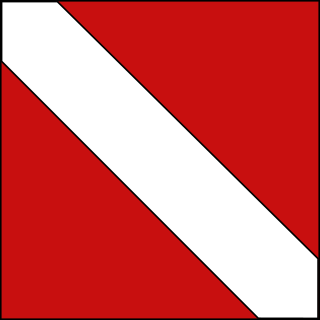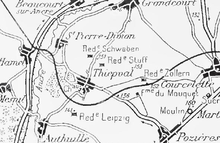The 19th Brigade is an Army Reserve formation of the British Army. As the 19th Infantry Brigade, it fought in the First and Second World War.

42nd Brigade was an infantry formation of the British Army during both World Wars. It was formed in August 1914 as part of Kitchener's Army, and was assigned to the 14th (Light) Division, serving on the Western Front. It was reformed in World War II for line of communication and deception purposes. As 42 Brigade it became a regional headquarters from 1982 to 2017.

The 39th Division was an infantry formation of the British Army, raised as part of Kitchener's New Armies during World War I. It did not have a regional title, but was composed primarily of recruits from the Midlands, London, and the south of England. Most of its original units had been raised by local communities, and bore the names of their towns or sponsors. After training and home service, it deployed to the Western Front in early 1916 and saw action at the Somme, at Ypres and against the German spring offensive of 1918. Following near-destruction at the Battle of the Lys, the division was reduced to a cadre, which spent the remainder of the war training newly arrived units of the American Expeditionary Forces (AEF). It was disbanded in July 1919 after the end of the war.

The article lists British Army reserve brigades in World War I. At the start of the war volunteers in the vast majority of cases joined their local infantry regiment's reserve battalion. As the army expanded rapidly, further reserve battalions and brigades were formed. After conscription was introduced in 1916 the existing regimental system could not cope with the large influx of recruits and the existing reserve brigades were incorporated into the Training Reserve, with an official complement of over 209,000 soldiers, in addition to the regimental training units.

The 59th Division was an infantry division of the British Army during World War I. It was formed in late 1914/early 1915 as a 2nd Line Territorial Force formation raised as a duplicate of the 46th Division. After training in the United Kingdom and seeing service in the Easter Rising in April 1916, the division joined the British Expeditionary Force (BEF) on the Western Front in early 1917. It saw action at Ypres and Cambrai, and was almost destroyed during the German Army's Spring Offensive in March 1918. The reconstituted division took part in the final advances of the war.

The 140th Brigade was an infantry brigade formation of the British Army's Territorial Army (TA) that had its origins in a South London Brigade of the former Volunteer Force. It served on the Western Front in the First World War and was recreated during the Second World War where it served only in the United Kingdom as a training formation.

The 141st Brigade was an infantry brigade of the Territorial Army, part of the British Army, that served in the First World War and remained in the United Kingdom throughout the Second World War.
41st Brigade was an infantry formation of the British Army during World War I. It was formed in August 1914 as part of the New Army, also known as Kitchener's Army, and was assigned to the 14th (Light) Division, serving on the Western Front. It was sometimes known as the 'Greenjacket Brigade' because it was composed of battalions of the King's Royal Rifle Corps and the Rifle Brigade, whose full dress uniforms were Rifle green.
The 91st Brigade was an infantry formation of the British Army during World War I. It was raised as part of 'Kitchener's Army' and was assigned to the 30th Division. After the original formation was converted into a reserve brigade, the number was transferred to a brigade of 'Manchester Pals'. The brigade landed in France at the end of 1915 and was transferred to the Regular 7th Division. It saw action at the Somme, Arras, and Ypres before being sent to the Italian Front, where it took part in the final Battle of Vittorio Veneto. The brigade's number was briefly revived during the 1950s.
The 214th Brigade was an infantry formation of the British Army during World War I. It was raised as a second line brigade of the Territorial Force and initially assigned to the 71st Division for coast defence. Later it was reorganised as an all-arms brigade group for service in North Russia, but this was cancelled and it was reassigned to the 67th Division, a training and home defence formation, until the end of the war.

98th Brigade was an infantry formation of the British Army created to command 'Kitchener's Army' units during World War I. It served on the Western Front from 1916, seeing action on the Somme, at Arras and Ypres, during the German spring offensive and the final Allied Hundred Days Offensive.
The 117th Brigade was an infantry formation of the British Army during World War I. Originally raised in December 1914 from locally-raised volunteer units of 'Kitchener's Army' known as 'Pals battalions', it was later redesignated and the number was transferred to a new 'Pals' brigade formed in July 1915. It fought with 39th Division on the Somme and the Ancre, at Ypres and in the German spring offensive. After the appalling casualties in that campaign it was relegated to a training organisation preparing US Army units for active service. It was disbanded shortly after the Armistice with Germany, but the number was transferred to another formation brought under 39th Division. It was disbanded in 1919.
The 118th Brigade was an infantry formation of the British Army during World War I. Originally raised in December 1914 as part of 'Kitchener's Army' it was later redesignated and the number was transferred to a new brigade formed in July 1915. This initially commanded 'Pals battalions' under training; later it took over experienced Territorial Force battalions that were already serving on the Western Front. It fought with 39th Division on the Somme and the Ancre, at Ypres and in the German spring offensive. After the appalling casualties in that campaign it was relegated to a training organisation preparing US Army units for active service. It was disbanded shortly after the Armistice with Germany.

The 123rd Brigade was an infantry formation of the British Army during World War I. It was raised as part of the New Armies. After the original 123rd Bde was renumbered, a new brigade was formed and served with the 41st Division from 1916 to 1919 on the Western Front, in Italy, and with the British Army of Occupation in Germany.
The 121st Brigade was an infantry brigade formation of the British Army during World War I. Part of Lord Kitchener's 'New Armies', it served in the 40th Division on the Western Front. The brigade number was reactivated for deception purposes during World War II.
The 6th Battalion, Royal Scots, was a unit of Britain's part-time Territorial Force. Beginning as a Volunteer unit formed from teetotallers in the city of Edinburgh in 1867, it later became affiliated to the Royal Scots. During World War I it served in the Senussi Campaign and on the Western Front. Postwar it was converted into a medium artillery battery.

The 5th Battalion, King's Regiment (Liverpool) was a volunteer unit of the King's Regiment (Liverpool) of the British Army. It traced its heritage to the raising in 1859 of a number rifle volunteer corps in Liverpool, which were soon consolidated into the 1st Lancashire Rifle Volunteer Corps (RVC). It was affiliated to the King's Regiment (Liverpool), and became its 1st Volunteer Battalion of the regiment. In 1908 the battalion was transferred to the new Territorial Force as the 5th Battalion, King's Regiment (Liverpool). It saw active service on the Western Front during World War I, as did its second line second-line battalion, and even a garrison battalion. Before World War II it again formed a second line battalion. Both served in home defence, but the 5th King's landed in Normandy on D Day as part of a specialist beach group 1939. When the Territorial Army was reduced in 1967, the 5th King's became a company of the Lancastrian Volunteers.
The 6th Battalion, Cheshire Regiment was a Territorial Force (TF) unit of the British Army. Formed in 1908 from Volunteer units recruited in Cheshire since 1859, it was one of the first TF units to go to the Western Front in World War I. It had a wandering existence, moving frequently from one command to another, seeing a considerable amount of combat at the Somme, Ypres, during the German spring offensive and in the final Allied Hundred Days Offensive. After the war it was amalgamated into a local artillery regiment.

The Sussex Royal Garrison Artillery and its successors were part-time coast defence units of the British Army from 1910 to 1932. Although the unit saw no active service, it supplied trained gunners to siege batteries engaged on the Western Front during World War I.

The 17th (Service) Battalion, King's Royal Rifle Corps, was an infantry unit recruited by the British Empire League as part of 'Kitchener's Army' in World War I. It served on the Western Front, including the battles of the Somme and the Ancre, the Third Battle of Ypres and the German spring offensives. After its losses the battalion was reduced to a training cadre for the rest of the war, helping to prepare newly arrived US troops and others for Trench warfare. It was disbanded in 1919.














